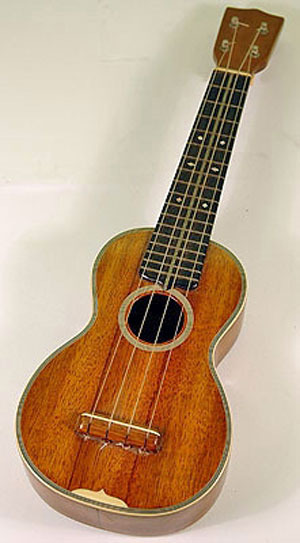The Ukulele
“A petite guitar imported from Honolulu, Hawaii, and firmly established in the land of its adoption, America; played like a mandolin, principally on front porches and in automobiles; regarded by some as an instrument of torture instead of an instrument of music.”
The Stars and Stripes (Paris, France), Jg. 1, Nr. 3, 22.2.1918, S. 2
The ukulele is a small guitar shaped Hawaiian instrument typically with four nylon strings tuned at the basic tuning of g–c–e–a. Like a guitar the tuning can be changed when needed to better suit the player’s needs. Its tone is soft and mellow making it a great instrument for vocal accompaniment. The instrument is played primarily by strumming chords, but in the late 1950s players began fingerpicking the strings, using it as a melodic instrument[1]. To provide a variety of timbres and greater range the ukulele is available in four sizes each with a unique number of frets: soprano /standard, 12 to 17 frets; concert, 19 frets; tenor, 18 to 22 frets; and baritone 22 frets [2].
Origin
The ukulele is not native to Hawaii was an approximate copy of the Portuguese machete da braça that was brought to the Hawaii by instrument makers from Madeira[3]. The Hawaiian people rapidly took to the instrument and began using it alongside the banjo to accompany hula dances. The ukulele was exposed to the rest of America on a large scale during the 1915 San Francisco Panama-Pacific Exposition[4].
Rise to Popularity
“Patriotic people have given up having German measles. They inquire instead a mild rash called ‘measlettes.’ The disease is contagious, but not so contagious as the ukulele fever which has swept over the whole continent.”
The Telegraph 1.6.1917, S. 5
“The country has all of a sudden gone mad over Hawaiian music.”
—SAN FRANCISCO CHRONICLE, AUGUST 27, 1916
The ukulele quickly rose in popularity across the U.S.A. because the instrument’s small size and light weight made it easier to transport than other instruments. The ukulele was marketed as easy to play [5] with some method books even claiming that no musical experience was needed, and that dedicated students could master the ukulele very quickly [6]. Not long after the Pan Pacific in Pan Alley and vaudeville songwriters were quick to cash in on the popularity of the ukulele and Hawaiian music, publishing a multitude of novelty songs with lyrics or titles that mentioned the ukulele and Hawaii [7], as well as “Hawaiian music” like “On the Beach at Waikiki” [8]. The success of such songs encouraged the increased publication of south sea songs and arrangements for ukuleles. The ukulele’s introduction to Canada is largely credited to the travelling circus guitarist, William Miles having heard the instrument while touring in Honolulu [9]. At the repeated request of patrons, Canadian vaudeville theatres began incorporating the popular “Hawaiian numbers” into the shows [10]. By 1916 the ukulele was sold at major Canadian music stores like Mclean & Co. and Whaley, Royce, & Co., where lessons were also offered [11].
_______________
[1] Walsh, Thomas J. ‘Ukulele’. Grove Music Online.
[2] Walsh
[3] Walsh
[4] "HAWAIIANS ARE ANGRY.; Islanders Want Legislation to Protect Ukuleles Manufactured There." New York Times, 19 Sept. 1915, https://query.nytimes.com/mem/archive-free/pdf?res=9E00E0D61731E733A0575AC1A96F9C946496D6CF. The New York Times.
[5] Tranquada, Jim, and John King. The Ukulele: A History. University of Hawai’i Press, 2012.
[6] Bailey, N. B. A Practical Method for Self Instruction on The Ukulele and Banjo Ukulele. Sherman Clay & Co., 1914. pp 3.
[7] Walsh
[8] Tranquada 98
[9] Tranquada 101
[10] Tranquada 101
[11] Tranquada 101
